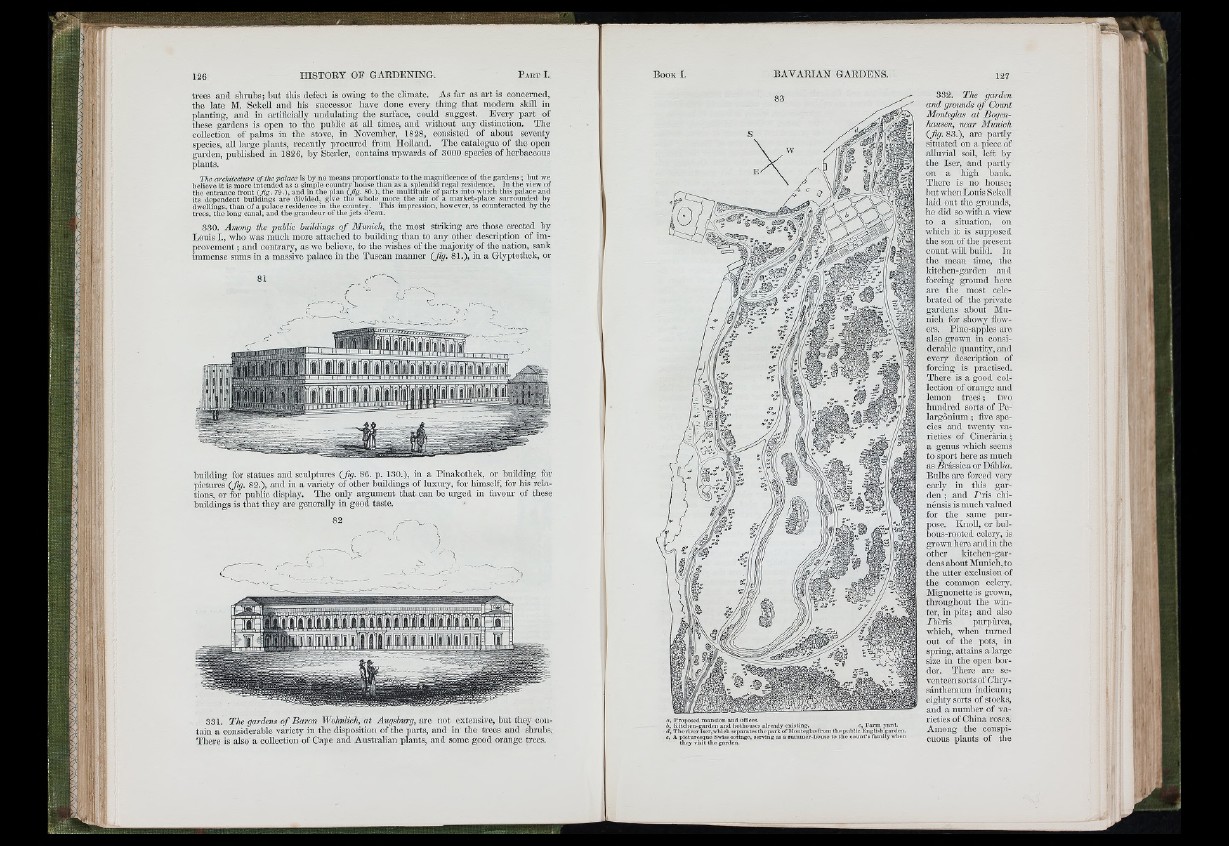
trees and slimbs; but this defect is owing to the climate. As far as art is concerned,
the late M. Sckcll and his successor have done every thing that modem skill in
planting, and in artificially undulating the surface, could suggest. Every part of
these gardens is open to the pubhc at all times, and without any distinction. The
collection of palms in the stove, in November, 1828, consisted of about seventy
species, all large plants, recently procured from Holland. The catalogue of the open
garden, published in 1826, hy Sterler, contains upwards of 3000 species of herbaceous
plants.
The architecture ofthe palace, is by no means proportionate to th e magnificence of the gardens; but we
believe it is more intended as a simple country house than as a splendid regal residence. In the view of
th e entrance front {fig- 7ö-)> iri the plan {fig. 80.), the multitude of parts into which this palace and
its dependent buildings are divided, give th e whole more the a ir of a market-place surrounded by
dwellings, than of a palace residence in the country. This impression, however, is counteracted by the
trees, the long canal, and the grandeur of th e jets d ’eau.
330. Among the puUic buildings o f Munich, the most striking are those erected by
Louis I., who was much more attached to building than to any other description of improvement
; and contrary, as wc believe, to the Avishes of the majority of the nation, sank
immense sums in a massive palace in the Tuscan manner ( fg . 81.), in a Glyptothek, or
.re
building for statues and sculptures ( fg . 86. p. 130.), in a Pinakothek, or building for
pictures ( fg . 82.), and in a variety of other buildings of luxury, for himself, for his relations,
or for public display. The only argument that can he urged in favour of these
buildings is that they arc generally in good taste.
331. The gardens o f Baron Wohnlich, at Augsburg, are not extensive, but they contain
a considerable variety in the disposition of the parts, and in the trees and shmhs.
There is also a collection of Cape and Australian plants, and some good orange ti-ees.
othousos already existing. c, I'a rm yarn
‘parates the p a rk of Monteglns from tho puhlic English garc
ttage, serving
as a sumiuer-bousc to th e count’s family w.
The riv er isor, which .
e, A picturesque Swiss cottage,Utoy visit th e garden.
127
332. The
and grounds o f Count
Monteglas at Bogen-
hausen, near Munich
( fg . 83.), are partly
situated on a piece of
alluvial soil, left by
tlie Iser, and partly
on a high bank.
There is no house;
hut AA'lien Louis Sckcll
laid out the grounds,
he did so Avith a view
to a situation, on
Avhicli it is supposed
the son of the present
count will build. In
the mean time, the
kitchen-garden and
forcing gi’ound here
arc the most celebrated
of the priA'ate
gardens about Munich
for shoAvy floAV-
ers. Pine-apples arc
also grown in considerable
quantity, and
every description of
forcing is practised.
There is a good collection
of orange and
lemon trees ; tAvo
hundred sorts of Pelargonium
; five species
aud tAventy A'a-
rieties of Cinerària ;
a genus Avhich seems
to sport here as much
as J5rassica or Dahha.
Bulbs are forced very
eai’ly in this garden
; and J 'ris chi-
nénsis is much valued
for the same purpose.
Kuoll, or bulbous
rooted celeiy, is
groAATi here and in tlie
other kitehen-gar-
dens about Munich, to
the utter exclusion of
the common celery.
Mignonette is groAvn,
throughout the winter,
in pits; and also
/b e ris pni-pùrea,
AA'hich, when turned
out of the pots, in
spring, attains a large
size in the open border.
There are seventeen
sorts of Chry-
santheramn indicum;
eighty sorts of stocks,
and a numher of varieties
of China roses.
Among the conspicuous
plants of the